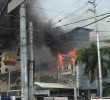At times, this may give them more security of land tenure even without the land title. “A certification attesting that they are certified beneficiaries could be issued,” Pascua said. “We have experiences to pattern this from. We can prove that this system works.”
The Board is composed of officials from the private housing sector, the national government housing agencies, the city mayor, city government officials and community associations. People’s organizations are also given three seats for every district in the Board while non-government organizations and the private sector are given one seat each.
But the urban group Kalipunan ng Damayang Mahihirap (Kadamay) said increasing the city government’s access to loans would not necessarily solve the prevailing homelessness in the city.
Alfred Depala, Kadamay secretary-general in Davao, said solving the problem of homelessness in the city requires more than improving the city government’s access to loans.
“How can they ensure that problems faced by the city government in dealing with homelessness in the past will not be repeated?” Depala asked.
He said that the main reason that the Urban Land Reform Program was stopped was because of the people’s incapacity to pay. Amortization payment for low cost-housing loans would cost one family, P700 per month, for a period of 25 years.
Depala also pointed out that urban poor dwellers who wanted to avail of a government housing project under the CMP had to meet all the stringent requirements.
To avail of a housing loan, informal settlers had to be a member of a “legitimate” association. They had to get an “originator,” an organization that would act as a guarantor. Just to be qualified applicants, they have to spend to meet all the requirements, adding up to the amount of loan that a poor beneficiary will incur, Depala explained.
“If a beneficiary cannot pay the amortization in three months under the CMP, he either faces penalty or forfeits the deal,” he said. Depala said the termination of Davao’s ULRP only attests that no housing program for the urban poor would succeed as long as the government could not improve the economic condition of the people.
“If the government is really serious in housing the urban poor, it must first provide means � jobs and mechanisms, such as livelihood programs�for them to afford housing,” he said.
He pointed out that the minimum daily wage that a worker receives in a day makes it very hard for himself and his family even to survive, how much more to pay a housing loan.
A worker in the region receives only P209 a day, much lower than the P622 a day that, according to the National Wages and Productivity Commission, a family of six (the average number of a Filipino Family) needs to survive. Besides, there’s a rising unemployment rate in the city.
The former city housing chief, Dataya, did not sound too enthusiastic about the new Shelter Code, either. “I am not saying it is useless,” Dataya said in an interview with davaotoday.com before the law was approved. “But don’t pin all your hopes in it.” He said the only way the housing problem of the city can be solved is through a local government program, like the Urban Land Reform Program (ULRP), where the city government purchases land classified for socialized housing and grants the lots to qualified beneficiaries in the form of loans.
But the program, which was introduced in the city in 1993, was short lived. The city government had to stop it because of poor collection and low repayment rates from the beneficiaries. “How do you maintain a budget of 40 million a year?” Dataya asked. Of the P130 million the city government spent to cater to the housing needs of 50 urban poor associations, the city was able to collect only 20-25 per cent of the total investment. (Cheryll Fiel/davaotoday.com)
Poverty









